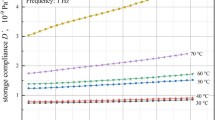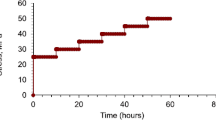Abstract
This article compares two available approaches for accelerating the creep response of viscoelastic materials, such as High Density Polyethylene (HDPE), which is increasingly gaining attention for use in construction. Thermal acceleration methods to predict the tensile creep of polymers are already available. The Time-Temperature Superposition (TTS) phenomenon is the basis of several available methods, and an ASTM standard for tensile creep of geosynthetics is based on one of its derivatives, the Stepped Isothermal Method (SIM). In this article, both TTS and SIM have been adapted to study the compressive creep of virgin HDPE. An alternate approach, based on the equivalence of strain energy density (SED) between conventional constant-stress creep tests and strain-controlled stress-strain tests, is also adapted for accelerated compressive creep of HDPE. There is remarkably a good agreement among the creep behaviors obtained from conventional tests, TTS, SIM, and SED predictions for virgin HDPE.















Similar content being viewed by others
References
H. Kawada, A. Kobiki, J. Koyanagi, and A. Hosoi, Long Term Durability of Polymer Matrix Composites under Hostile Environments, Mater. Sci Eng. A, 2005, 412, p 159–164
C. Chen, H. Salim, J.J. Bowders, E. Loher, and J. Owen, Creep Behavior of Recycled Plastic Lumber in Slope Stabilization Applications, ASCE J. Mater. Civil Eng., 2007, 19(2), p 130–138
J. Huang and J. Gibson, Creep of Sandwich Beams with Polymer Foam Cores, ASCE J. Mater. Civil Eng., 1990, 2(3), p 171–182
G. McClure and Y. Mohammadi, Compression Creep of Pultruded W-Glass-Reinforced-Plastic Angles, ASCE J. Mater. Civil Eng., 1995, 7(4), p 269–276
S.M. Merry, J.D. Bray, and S. Yoshitomi, Axisymmetric Temperature- and Stress-Dependent Creep Response of ‘New’ and ‘Old’ HDPE, Geomembr. Geosynt. Int., 2005, 12(3), p 156–161
L. Cessna, Stress Time Superposition for Creep Data for Polypropylene and Coupled Glass Reinforced Polypropylene, Polym. Eng. Sci., 1971, 13, p 211–219
R. Elleuch and W. Tak Tak, Viscoelastic Behavior of HDPE Polymer Using Tensile and Compressive Loading, J. Mater. Eng. Perform., 2006, 15(1), p 111–116
L. Nielson and R. Landel. Mechanical Properties of Polymers and Composites, 2nd edn. (Marcel Dekker, New York, 1994)
B. Read, P. Tomlins, and G. Dean, Physical Aging and Short Term Creep in Amorphous and Semicrystalline Polymers, Polymer, 1990, 31, p 1204–1215
C. Dong, S. Zhu, M. Mizuno, and M. Hashimoto, Modeling and Prediction of Compressive Creep of Silane-Treated TiO2/High-Density Polyethylene, J. Mater. Sci. Springer, 2010, 45, p 3506–3513
J.D. Ferry, Viscoelastic Properties of Polymers, 3rd ed., Wiley, New York, 1980
S. Matsuoka, Failure of Plastics, Chap. 3, W. Brostow and R. Comeliussen, Ed., Hansler Publishers, 1986, p 24–59
M. Iskander and M. Hassan, State of the Practice Review in FRP Composite Piling, ASCE J. Compos. Constr., 1998, 2(3), p 116–120
K. Farrag, Development of an Accelerated Creep Testing Procedure for Geosynthetics. II. Analysis, ASTM Geotech. Test. J., 1998, 21(2), p 38–44
Y.G. Hsuan and S.S. Yeo, Comparing the Creep Behavior of High Density Polyethylene Geogrid Using Two Acceleration Method, Slopes and Retaining Structures Under Seismic and Static Conditions (GSP 140), ASCE, 2005, p 166. doi:10.1061/40787(166)23
J.G. Zornberg, B.R. Byler, and J.W. Knudsen, Creep of Geotextiles Using Time-Temperature Superposition Methods, ASCE J. Geotech. Geoenviron. Eng., 2004, 130(11), p 1158–1168
J.S. Thornton, S.R. Allen, R.W. Thomas, and D. Sandri, The Stepped Isothermal Method for Time-Temperature Superposition and Its Application to Creep Data on Polyester Yarn, Proc. 6th Int. Conf. on Geosynthetic, Atlanta, 1998, p 699–706
J.S. Thornton, J.N. Paulson, and D. Sandri, Conventional and Stepped Isothermal Methods for Characterizing Long Term Creep Strength of Polyester Geogrids, Proc. 6th Int. Conf. on Geosynthetic, Atlanta, 1998, p 691–698
B.S. Bueno, M.A. Costanzi, and J.G. Zornberg, Conventional and Accelerated Creep Tests on Nonwoven Needle-Punched Geotextiles, Geosynth. Int., 2005, 12(6), p 276–287
Y.G. Hsuan and S.S. Yeo, Compression Creep Behavior of Geofoam Using the Stepped Isothermal Method, Geosynthetics Research and Development in Progress (GRI-18), ASCE, 2005, p 161. doi:10.1061/40782(161)12
S. Arrhenius, Theories of Solutions, Oxford University Press, 1912
A. Bozorg-Haddad, “Creep of Fiber Reinforced Polymer (FRP) Pile Materials,” Dissertation, Polytechnic Institute of New York University, 2009
J. Aklonisa and W. MacKnight, Introduction to Polymer Viscoelasticity, 2nd ed., Wiley, 1983, p 36–56
L. Hollaway, Polymers and Polymer Composites in Construction, Thomas Telford, 1990, 275 p
S. Matsuoka, H. Bair, S. Bearder, H. Kern, and J. Ryan, Analysis of Non Linear Stress Relaxation in Polymer Glasses, Polym. Eng. Sci., 1977, 18(14), p 1073–1080
J.K. Lynch, “Time Dependence of the Mechanical Properties of an Immiscible Polymer Blend,” PhD. dissertation, Rutgers University, NJ, 2002
K. Van Ness, T. Nosker, R. Renfree, and J. Killion, Creep Behavior of Commercially Produced Plastic Lumber, Proceedings, 56th ANTEC Conference, Society of Plastics Engineers, Atlanta, 1998, p 2916–2920
S.M. Merry and J.D. Bray, Time Dependant Mechanical Response of HDPE Geomembranes, ASCE J. Geotech. Geoenviron. Eng., 1997, 123(1), p 57–65
A. Pramanick and M. Sain, Nonlinear Viscoelastic Creep Characterization of HDPE-Rice Husk Composites, Polym. Polym. Compos., 2005, 13(6), p 581–598
A. Pramanick and M. Sain, Nonlinear Viscoelastic Creep Characterization of HDPE-Agro-Fiber Composites, J. Compos. Mater., 2006, 40(5), p 417–431
A. Pramanick and M. Sain, Temperature-Stress Equivalency in Nonlinear Viscoelastic Creep Characterization of Thermoplastic/Agro-Fiber Composites, J. Thermoplast. Compos. Mater., 2006, 19, p 35–60
L. Struik, The Mechanical and Physical Aging of Semi-Crystalline Polymers: 3, Polymer, 1989, 30, p 799–814
L. Brinson and T. Gates, The Effects of Physical Aging on Long-Term Creep of Polymers and Polymer Matrix Composites, Int. J. Solids Struct., 1995, 32(6/7), p 827–846
J. Hutchinson, Physical Aging of Polymers, Progress in Polymer Scieve, Vol 20, Elsevier, 1995, p 703–760
J. Sullivan, Creep and Physical Aging of Composites, Compos. Sci. Technol., 1990, 39, p 207–232
Acknowledgments
Funding of FHWA and The Empire Development Corporation is gratefully acknowledged. The authors thank Mahsa Rejaei, Carlos Cabrerra, Hsiao Wang, and Saumil Parikh who carried out the laboratory tests described herein under the authors' supervision.
Author information
Authors and Affiliations
Corresponding author
Rights and permissions
About this article
Cite this article
Bozorg-Haddad, A., Iskander, M. Comparison of Accelerated Compressive Creep Behavior of Virgin HDPE Using Thermal and Energy Approaches. J. of Materi Eng and Perform 20, 1219–1229 (2011). https://doi.org/10.1007/s11665-010-9743-9
Received:
Revised:
Published:
Issue Date:
DOI: https://doi.org/10.1007/s11665-010-9743-9




